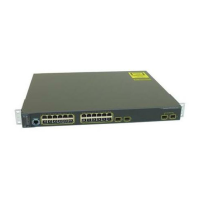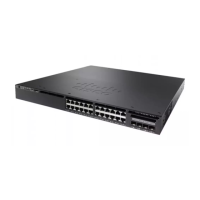◦
For optimal one-to-many application performance, SSM is appropriate but requires IGMP version
3 support.
•
Before you configure PIM stub routing, check that you have met these conditions:
◦
You must have IP multicast routing configured on both the stub router and the central router. You
must also have PIM mode (dense-mode, sparse-mode, or sparse-dense-mode) configured on the
uplink interface of the stub router.
◦
You must also configure either Enhanced Interior Gateway Routing Protocol (EIGRP) stub routing
or Open Shortest Path First (OSPF) stub routing on the device.
◦
The PIM stub router does not route the transit traffic between the distribution routers. Unicast
(EIGRP) stub routing enforces this behavior. You must configure unicast stub routing to assist the
PIM stub router behavior.
For information about EIGRP or OSPF configurations, see the Catalyst 3850 Routing
Configuration Guide, Release 3SE.
Note
Restrictions for PIM
The following are the restrictions for configuring PIM:
•
PIM is not supported when running the LAN Base feature set.
•
Bidirectional PIM is not supported.
PIMv1 and PIMv2 Interoperability
To avoid misconfiguring multicast routing on your device, review the information in this section.
The Cisco PIMv2 implementation provides interoperability and transition between Version 1 and Version 2,
although there might be some minor problems.
You can upgrade to PIMv2 incrementally. PIM Versions 1 and 2 can be configured on different routers and
multilayer devices within one network. Internally, all routers and multilayer devices on a shared media network
must run the same PIM version. Therefore, if a PIMv2 device detects a PIMv1 device, the Version 2 device
downgrades itself to Version 1 until all Version 1 devices have been shut down or upgraded.
PIMv2 uses the BSR to discover and announce RP-set information for each group prefix to all the routers and
multilayer devices in a PIM domain. PIMv1, together with the Auto-RP feature, can perform the same tasks
as the PIMv2 BSR. However, Auto-RP is a standalone protocol, separate from PIMv1, and is a proprietary
Cisco protocol. PIMv2 is a standards track protocol in the IETF.
We recommend that you use PIMv2. The BSR function interoperates with Auto-RP on Cisco routers and
multilayer devices.
Note
IP Multicast Routing Configuration Guide, Cisco IOS XE Release 3.6E (Catalyst 3850 Switches)
122 OL-32598-01
Configuring PIM
Restrictions for PIM
